Analyzing HRM Strategies: A Hospital Case Study and Recommendations
VerifiedAdded on 2020/03/01
|6
|1471
|37
Case Study
AI Summary
This case study analyzes the HRM operations of a hospital facing issues such as absenteeism, poor customer service, and high employee turnover. The solution recommends establishing a fully-fledged HR department to address employee relations, managerial styles, and performance management. Key strategies include employee induction and training, feedback mechanisms, reward programs, and conflict resolution. The analysis also highlights the importance of building a sustainable HR capacity through strategic alignment, results-driven approaches, workforce management, relationship building, professional expertise, and change management. The recommendations aim to improve the hospital's performance by fostering a positive work environment, enhancing employee engagement, and ensuring high-quality patient care. The document emphasizes the need for clear communication, effective performance management, and a culture that embraces change to achieve long-term success.
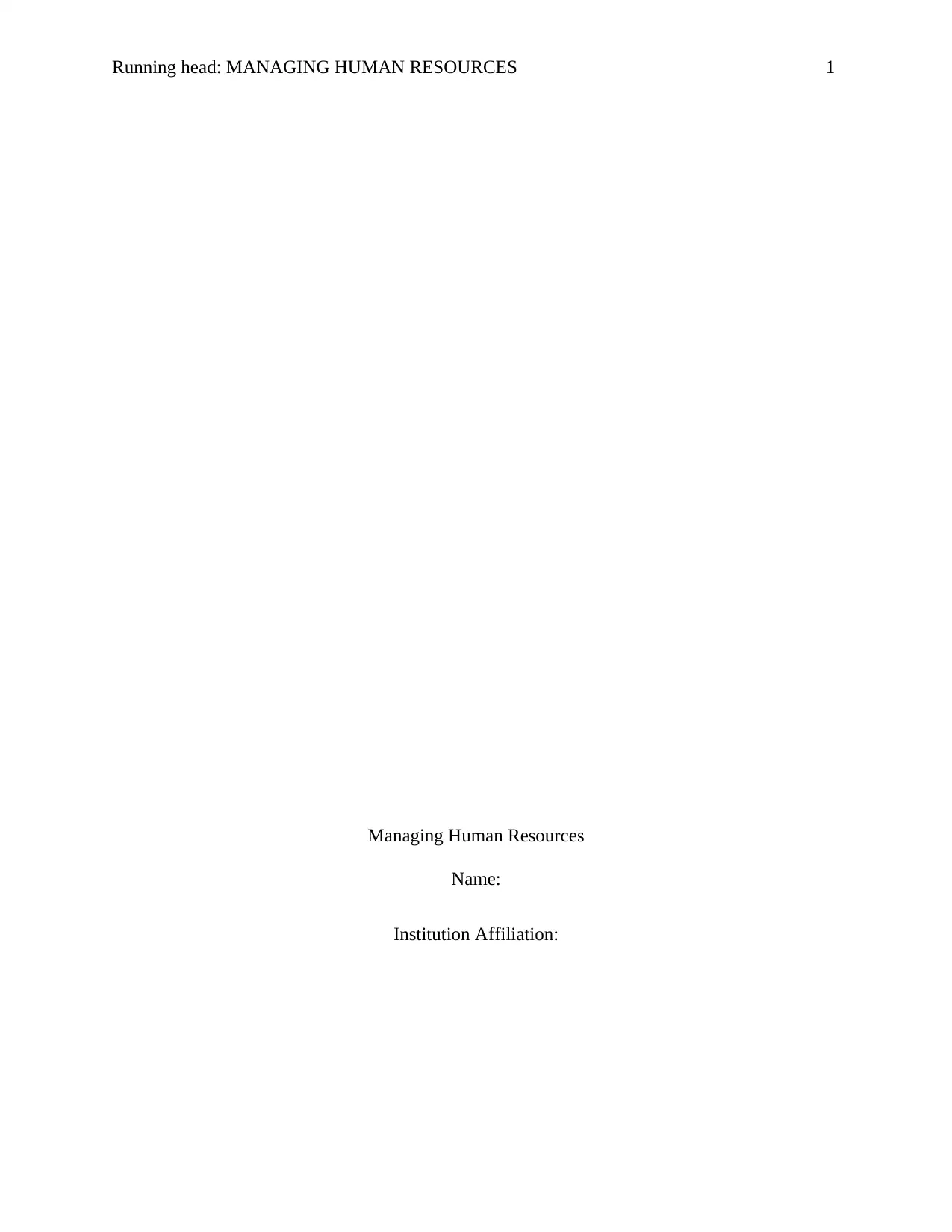
Running head: MANAGING HUMAN RESOURCES 1
Managing Human Resources
Name:
Institution Affiliation:
Managing Human Resources
Name:
Institution Affiliation:
Paraphrase This Document
Need a fresh take? Get an instant paraphrase of this document with our AI Paraphraser
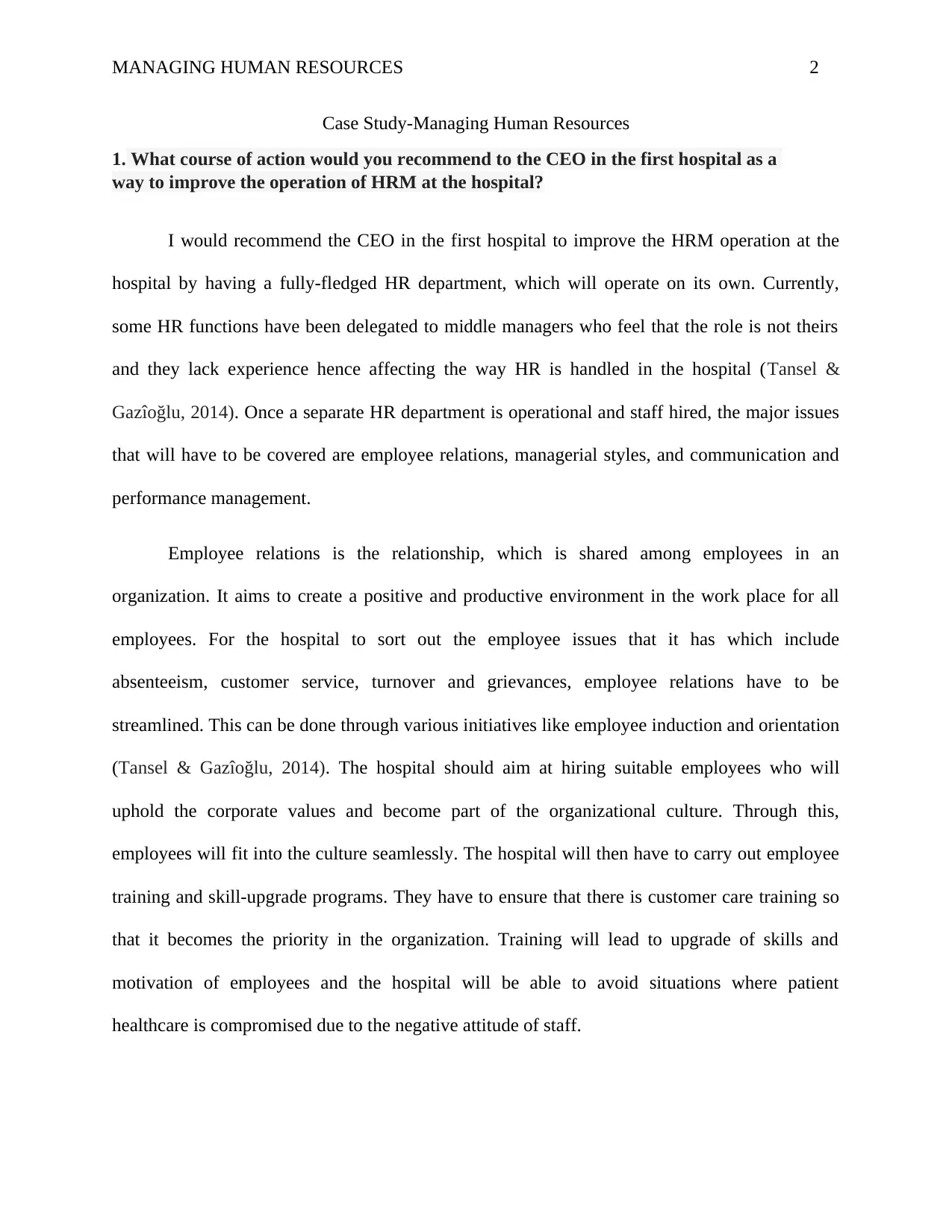
MANAGING HUMAN RESOURCES 2
Case Study-Managing Human Resources
1. What course of action would you recommend to the CEO in the first hospital as a
way to improve the operation of HRM at the hospital?
I would recommend the CEO in the first hospital to improve the HRM operation at the
hospital by having a fully-fledged HR department, which will operate on its own. Currently,
some HR functions have been delegated to middle managers who feel that the role is not theirs
and they lack experience hence affecting the way HR is handled in the hospital (Tansel &
Gazîoğlu, 2014). Once a separate HR department is operational and staff hired, the major issues
that will have to be covered are employee relations, managerial styles, and communication and
performance management.
Employee relations is the relationship, which is shared among employees in an
organization. It aims to create a positive and productive environment in the work place for all
employees. For the hospital to sort out the employee issues that it has which include
absenteeism, customer service, turnover and grievances, employee relations have to be
streamlined. This can be done through various initiatives like employee induction and orientation
(Tansel & Gazîoğlu, 2014). The hospital should aim at hiring suitable employees who will
uphold the corporate values and become part of the organizational culture. Through this,
employees will fit into the culture seamlessly. The hospital will then have to carry out employee
training and skill-upgrade programs. They have to ensure that there is customer care training so
that it becomes the priority in the organization. Training will lead to upgrade of skills and
motivation of employees and the hospital will be able to avoid situations where patient
healthcare is compromised due to the negative attitude of staff.
Case Study-Managing Human Resources
1. What course of action would you recommend to the CEO in the first hospital as a
way to improve the operation of HRM at the hospital?
I would recommend the CEO in the first hospital to improve the HRM operation at the
hospital by having a fully-fledged HR department, which will operate on its own. Currently,
some HR functions have been delegated to middle managers who feel that the role is not theirs
and they lack experience hence affecting the way HR is handled in the hospital (Tansel &
Gazîoğlu, 2014). Once a separate HR department is operational and staff hired, the major issues
that will have to be covered are employee relations, managerial styles, and communication and
performance management.
Employee relations is the relationship, which is shared among employees in an
organization. It aims to create a positive and productive environment in the work place for all
employees. For the hospital to sort out the employee issues that it has which include
absenteeism, customer service, turnover and grievances, employee relations have to be
streamlined. This can be done through various initiatives like employee induction and orientation
(Tansel & Gazîoğlu, 2014). The hospital should aim at hiring suitable employees who will
uphold the corporate values and become part of the organizational culture. Through this,
employees will fit into the culture seamlessly. The hospital will then have to carry out employee
training and skill-upgrade programs. They have to ensure that there is customer care training so
that it becomes the priority in the organization. Training will lead to upgrade of skills and
motivation of employees and the hospital will be able to avoid situations where patient
healthcare is compromised due to the negative attitude of staff.
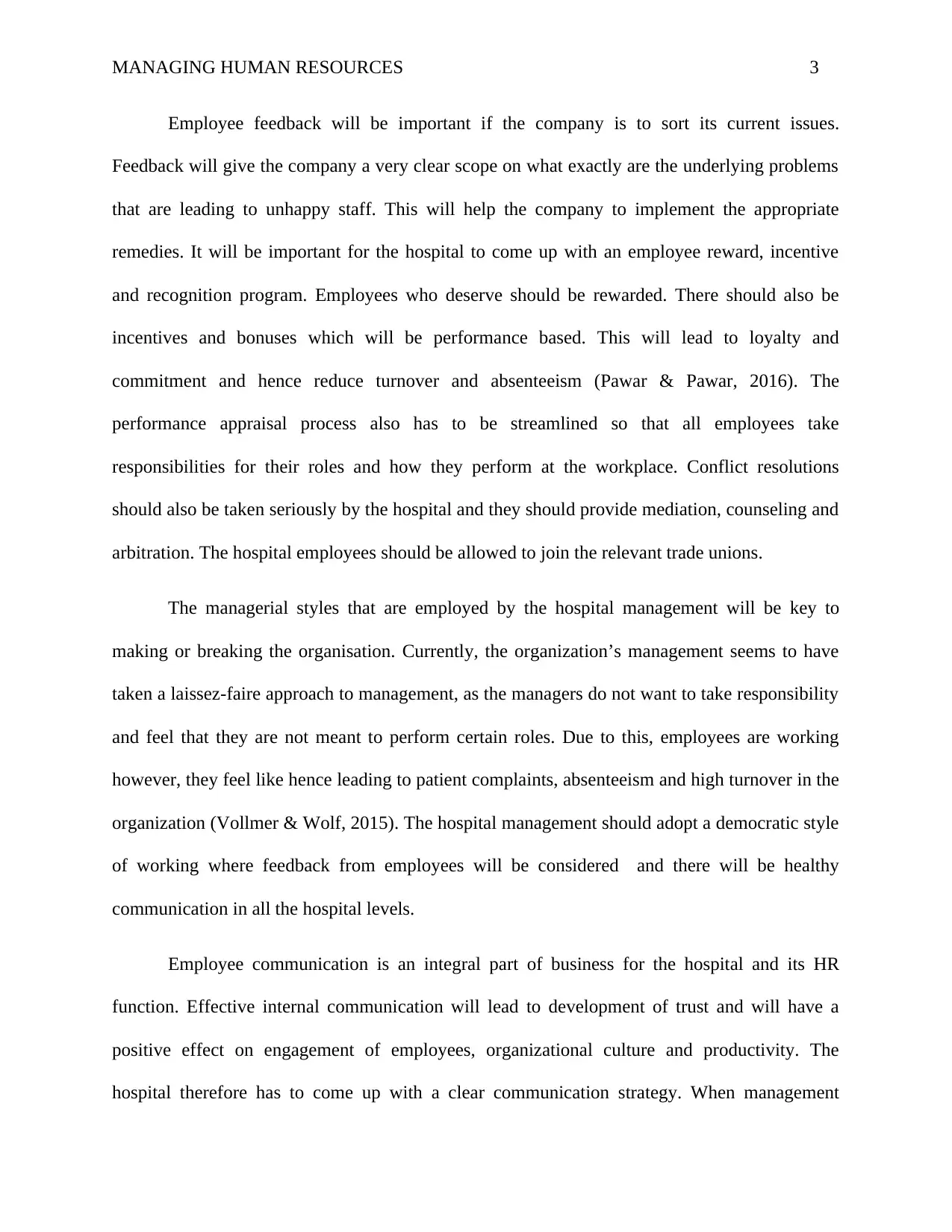
MANAGING HUMAN RESOURCES 3
Employee feedback will be important if the company is to sort its current issues.
Feedback will give the company a very clear scope on what exactly are the underlying problems
that are leading to unhappy staff. This will help the company to implement the appropriate
remedies. It will be important for the hospital to come up with an employee reward, incentive
and recognition program. Employees who deserve should be rewarded. There should also be
incentives and bonuses which will be performance based. This will lead to loyalty and
commitment and hence reduce turnover and absenteeism (Pawar & Pawar, 2016). The
performance appraisal process also has to be streamlined so that all employees take
responsibilities for their roles and how they perform at the workplace. Conflict resolutions
should also be taken seriously by the hospital and they should provide mediation, counseling and
arbitration. The hospital employees should be allowed to join the relevant trade unions.
The managerial styles that are employed by the hospital management will be key to
making or breaking the organisation. Currently, the organization’s management seems to have
taken a laissez-faire approach to management, as the managers do not want to take responsibility
and feel that they are not meant to perform certain roles. Due to this, employees are working
however, they feel like hence leading to patient complaints, absenteeism and high turnover in the
organization (Vollmer & Wolf, 2015). The hospital management should adopt a democratic style
of working where feedback from employees will be considered and there will be healthy
communication in all the hospital levels.
Employee communication is an integral part of business for the hospital and its HR
function. Effective internal communication will lead to development of trust and will have a
positive effect on engagement of employees, organizational culture and productivity. The
hospital therefore has to come up with a clear communication strategy. When management
Employee feedback will be important if the company is to sort its current issues.
Feedback will give the company a very clear scope on what exactly are the underlying problems
that are leading to unhappy staff. This will help the company to implement the appropriate
remedies. It will be important for the hospital to come up with an employee reward, incentive
and recognition program. Employees who deserve should be rewarded. There should also be
incentives and bonuses which will be performance based. This will lead to loyalty and
commitment and hence reduce turnover and absenteeism (Pawar & Pawar, 2016). The
performance appraisal process also has to be streamlined so that all employees take
responsibilities for their roles and how they perform at the workplace. Conflict resolutions
should also be taken seriously by the hospital and they should provide mediation, counseling and
arbitration. The hospital employees should be allowed to join the relevant trade unions.
The managerial styles that are employed by the hospital management will be key to
making or breaking the organisation. Currently, the organization’s management seems to have
taken a laissez-faire approach to management, as the managers do not want to take responsibility
and feel that they are not meant to perform certain roles. Due to this, employees are working
however, they feel like hence leading to patient complaints, absenteeism and high turnover in the
organization (Vollmer & Wolf, 2015). The hospital management should adopt a democratic style
of working where feedback from employees will be considered and there will be healthy
communication in all the hospital levels.
Employee communication is an integral part of business for the hospital and its HR
function. Effective internal communication will lead to development of trust and will have a
positive effect on engagement of employees, organizational culture and productivity. The
hospital therefore has to come up with a clear communication strategy. When management
⊘ This is a preview!⊘
Do you want full access?
Subscribe today to unlock all pages.

Trusted by 1+ million students worldwide
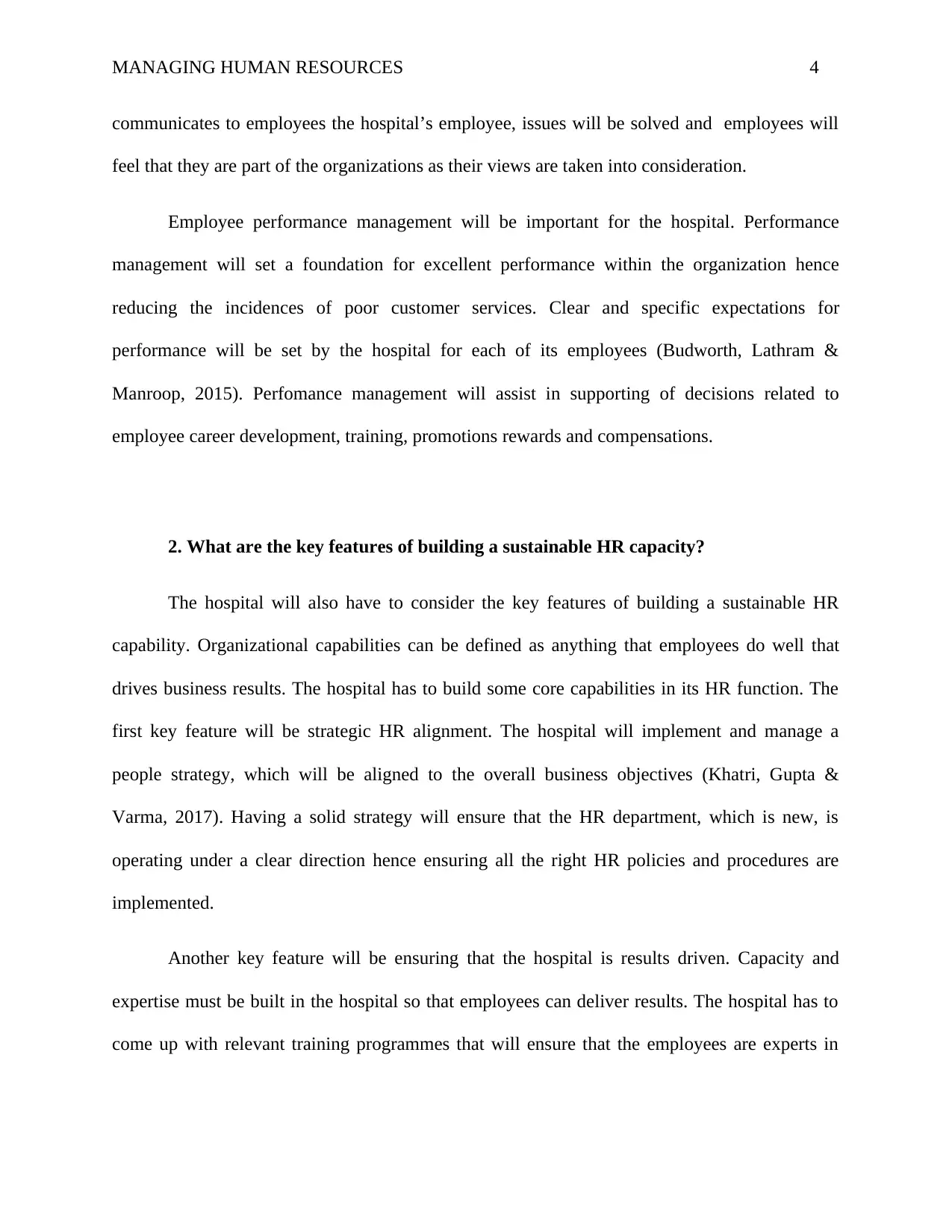
MANAGING HUMAN RESOURCES 4
communicates to employees the hospital’s employee, issues will be solved and employees will
feel that they are part of the organizations as their views are taken into consideration.
Employee performance management will be important for the hospital. Performance
management will set a foundation for excellent performance within the organization hence
reducing the incidences of poor customer services. Clear and specific expectations for
performance will be set by the hospital for each of its employees (Budworth, Lathram &
Manroop, 2015). Perfomance management will assist in supporting of decisions related to
employee career development, training, promotions rewards and compensations.
2. What are the key features of building a sustainable HR capacity?
The hospital will also have to consider the key features of building a sustainable HR
capability. Organizational capabilities can be defined as anything that employees do well that
drives business results. The hospital has to build some core capabilities in its HR function. The
first key feature will be strategic HR alignment. The hospital will implement and manage a
people strategy, which will be aligned to the overall business objectives (Khatri, Gupta &
Varma, 2017). Having a solid strategy will ensure that the HR department, which is new, is
operating under a clear direction hence ensuring all the right HR policies and procedures are
implemented.
Another key feature will be ensuring that the hospital is results driven. Capacity and
expertise must be built in the hospital so that employees can deliver results. The hospital has to
come up with relevant training programmes that will ensure that the employees are experts in
communicates to employees the hospital’s employee, issues will be solved and employees will
feel that they are part of the organizations as their views are taken into consideration.
Employee performance management will be important for the hospital. Performance
management will set a foundation for excellent performance within the organization hence
reducing the incidences of poor customer services. Clear and specific expectations for
performance will be set by the hospital for each of its employees (Budworth, Lathram &
Manroop, 2015). Perfomance management will assist in supporting of decisions related to
employee career development, training, promotions rewards and compensations.
2. What are the key features of building a sustainable HR capacity?
The hospital will also have to consider the key features of building a sustainable HR
capability. Organizational capabilities can be defined as anything that employees do well that
drives business results. The hospital has to build some core capabilities in its HR function. The
first key feature will be strategic HR alignment. The hospital will implement and manage a
people strategy, which will be aligned to the overall business objectives (Khatri, Gupta &
Varma, 2017). Having a solid strategy will ensure that the HR department, which is new, is
operating under a clear direction hence ensuring all the right HR policies and procedures are
implemented.
Another key feature will be ensuring that the hospital is results driven. Capacity and
expertise must be built in the hospital so that employees can deliver results. The hospital has to
come up with relevant training programmes that will ensure that the employees are experts in
Paraphrase This Document
Need a fresh take? Get an instant paraphrase of this document with our AI Paraphraser
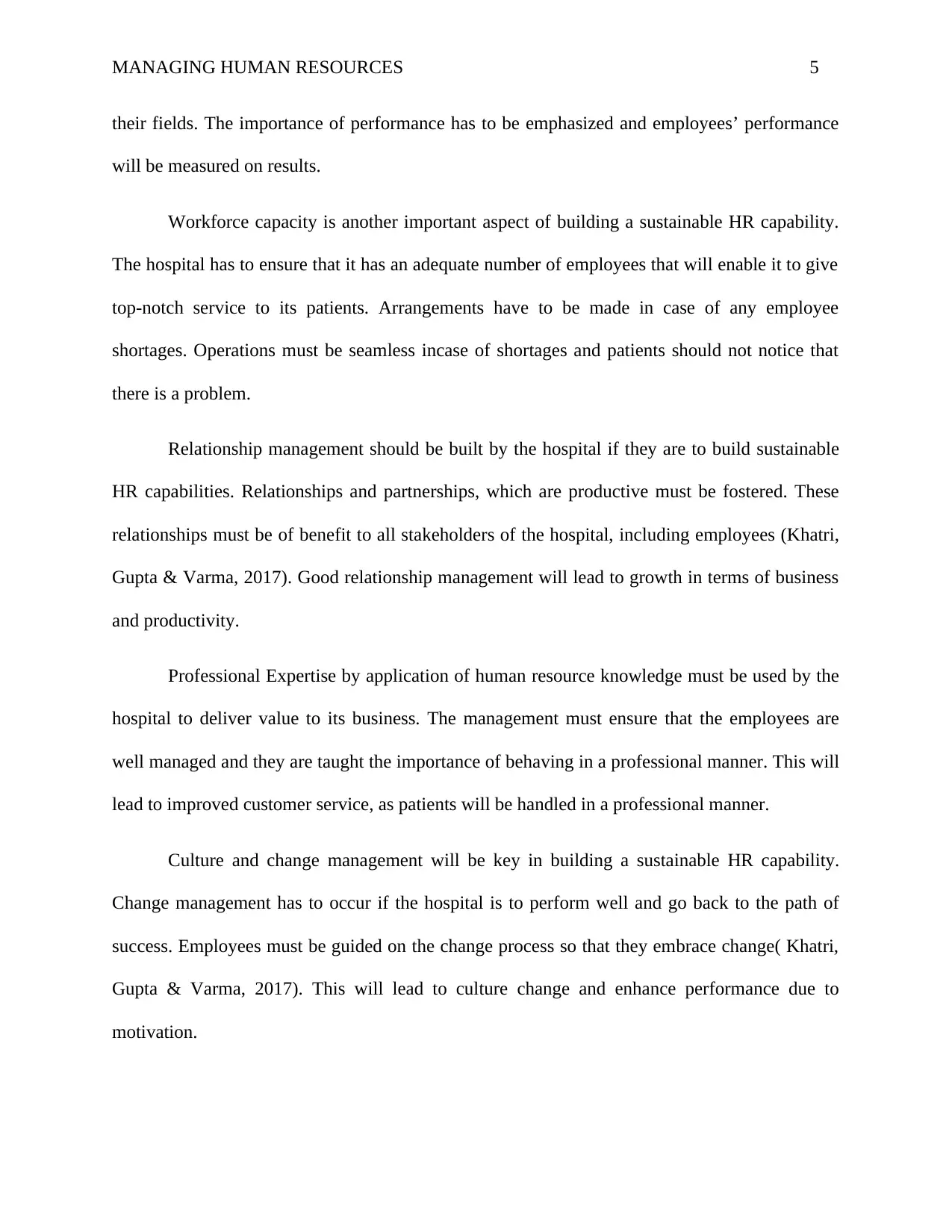
MANAGING HUMAN RESOURCES 5
their fields. The importance of performance has to be emphasized and employees’ performance
will be measured on results.
Workforce capacity is another important aspect of building a sustainable HR capability.
The hospital has to ensure that it has an adequate number of employees that will enable it to give
top-notch service to its patients. Arrangements have to be made in case of any employee
shortages. Operations must be seamless incase of shortages and patients should not notice that
there is a problem.
Relationship management should be built by the hospital if they are to build sustainable
HR capabilities. Relationships and partnerships, which are productive must be fostered. These
relationships must be of benefit to all stakeholders of the hospital, including employees (Khatri,
Gupta & Varma, 2017). Good relationship management will lead to growth in terms of business
and productivity.
Professional Expertise by application of human resource knowledge must be used by the
hospital to deliver value to its business. The management must ensure that the employees are
well managed and they are taught the importance of behaving in a professional manner. This will
lead to improved customer service, as patients will be handled in a professional manner.
Culture and change management will be key in building a sustainable HR capability.
Change management has to occur if the hospital is to perform well and go back to the path of
success. Employees must be guided on the change process so that they embrace change( Khatri,
Gupta & Varma, 2017). This will lead to culture change and enhance performance due to
motivation.
their fields. The importance of performance has to be emphasized and employees’ performance
will be measured on results.
Workforce capacity is another important aspect of building a sustainable HR capability.
The hospital has to ensure that it has an adequate number of employees that will enable it to give
top-notch service to its patients. Arrangements have to be made in case of any employee
shortages. Operations must be seamless incase of shortages and patients should not notice that
there is a problem.
Relationship management should be built by the hospital if they are to build sustainable
HR capabilities. Relationships and partnerships, which are productive must be fostered. These
relationships must be of benefit to all stakeholders of the hospital, including employees (Khatri,
Gupta & Varma, 2017). Good relationship management will lead to growth in terms of business
and productivity.
Professional Expertise by application of human resource knowledge must be used by the
hospital to deliver value to its business. The management must ensure that the employees are
well managed and they are taught the importance of behaving in a professional manner. This will
lead to improved customer service, as patients will be handled in a professional manner.
Culture and change management will be key in building a sustainable HR capability.
Change management has to occur if the hospital is to perform well and go back to the path of
success. Employees must be guided on the change process so that they embrace change( Khatri,
Gupta & Varma, 2017). This will lead to culture change and enhance performance due to
motivation.
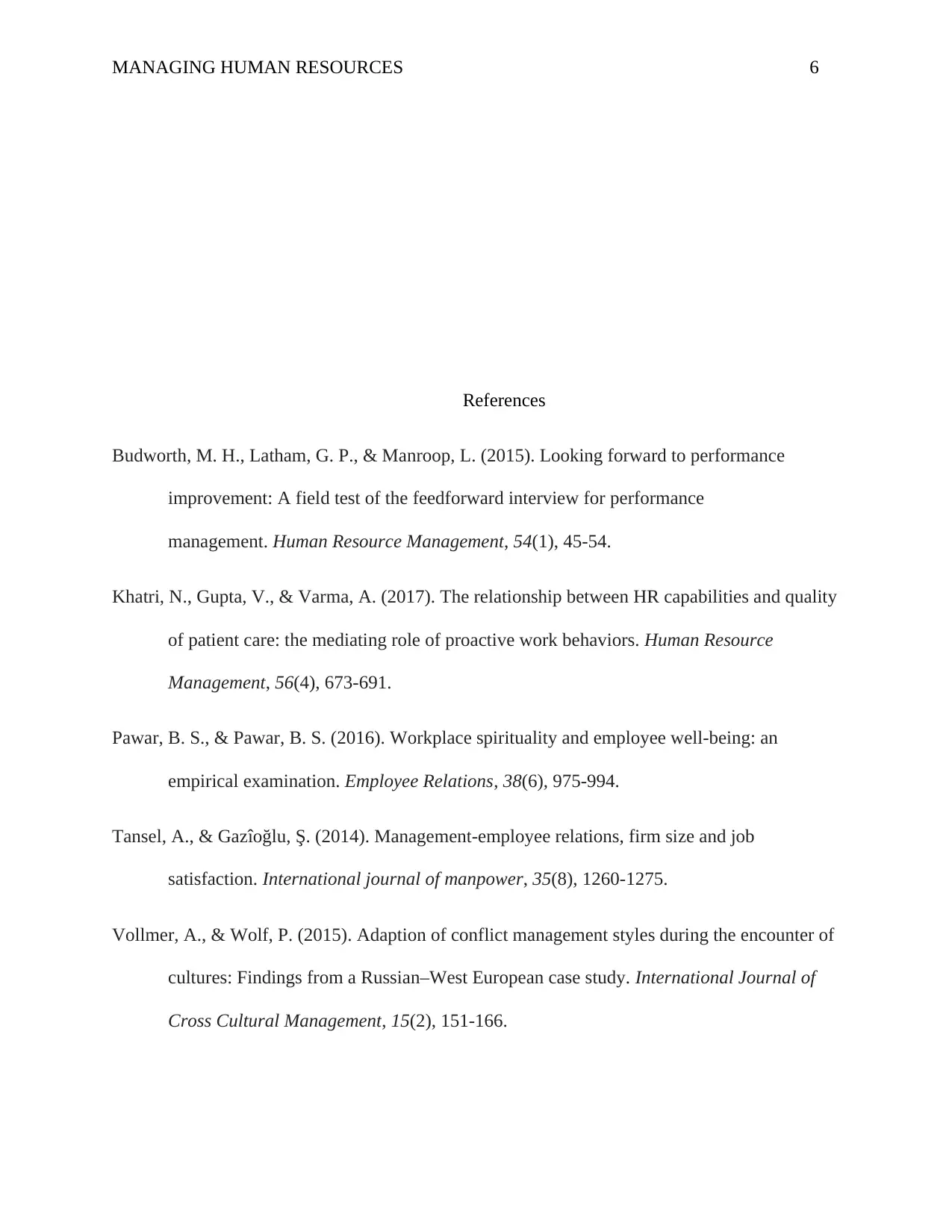
MANAGING HUMAN RESOURCES 6
References
Budworth, M. H., Latham, G. P., & Manroop, L. (2015). Looking forward to performance
improvement: A field test of the feedforward interview for performance
management. Human Resource Management, 54(1), 45-54.
Khatri, N., Gupta, V., & Varma, A. (2017). The relationship between HR capabilities and quality
of patient care: the mediating role of proactive work behaviors. Human Resource
Management, 56(4), 673-691.
Pawar, B. S., & Pawar, B. S. (2016). Workplace spirituality and employee well-being: an
empirical examination. Employee Relations, 38(6), 975-994.
Tansel, A., & Gazîoğlu, Ş. (2014). Management-employee relations, firm size and job
satisfaction. International journal of manpower, 35(8), 1260-1275.
Vollmer, A., & Wolf, P. (2015). Adaption of conflict management styles during the encounter of
cultures: Findings from a Russian–West European case study. International Journal of
Cross Cultural Management, 15(2), 151-166.
References
Budworth, M. H., Latham, G. P., & Manroop, L. (2015). Looking forward to performance
improvement: A field test of the feedforward interview for performance
management. Human Resource Management, 54(1), 45-54.
Khatri, N., Gupta, V., & Varma, A. (2017). The relationship between HR capabilities and quality
of patient care: the mediating role of proactive work behaviors. Human Resource
Management, 56(4), 673-691.
Pawar, B. S., & Pawar, B. S. (2016). Workplace spirituality and employee well-being: an
empirical examination. Employee Relations, 38(6), 975-994.
Tansel, A., & Gazîoğlu, Ş. (2014). Management-employee relations, firm size and job
satisfaction. International journal of manpower, 35(8), 1260-1275.
Vollmer, A., & Wolf, P. (2015). Adaption of conflict management styles during the encounter of
cultures: Findings from a Russian–West European case study. International Journal of
Cross Cultural Management, 15(2), 151-166.
⊘ This is a preview!⊘
Do you want full access?
Subscribe today to unlock all pages.

Trusted by 1+ million students worldwide
1 out of 6
Related Documents
Your All-in-One AI-Powered Toolkit for Academic Success.
+13062052269
info@desklib.com
Available 24*7 on WhatsApp / Email
![[object Object]](/_next/static/media/star-bottom.7253800d.svg)
Unlock your academic potential
Copyright © 2020–2025 A2Z Services. All Rights Reserved. Developed and managed by ZUCOL.





